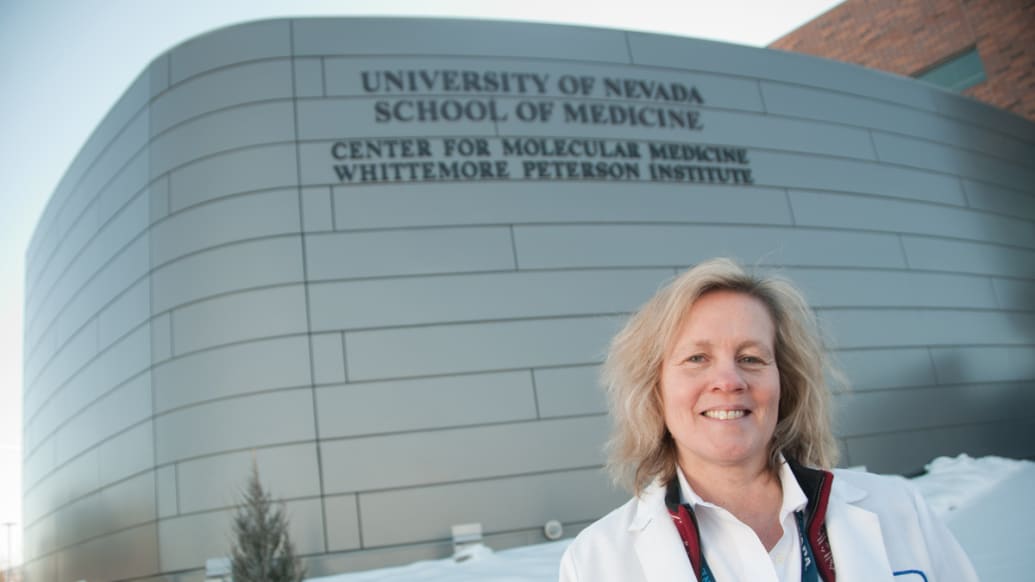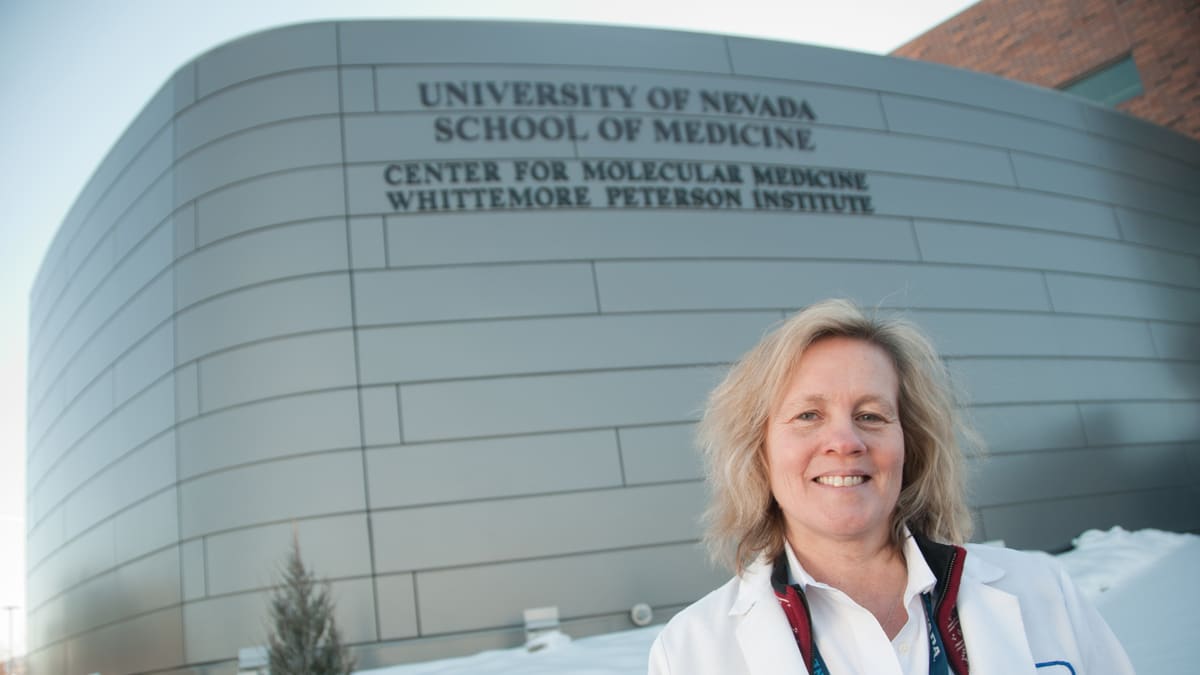On Nov. 9, 2011, Judy Mikovits, a well-known chronic fatigue syndrome researcher at the center of one of the strangest scientific dramas in recent memory, found herself devising the following plan.
She would have to escape by boat.
There was a man in a car in front of her house in Oxnard, Calif., waiting to serve her with a temporary restraining order demanding the return of stolen property to the Whittemore Peterson Institute in Reno, Nev., from which she recently had been fired.
She took the small boat moored behind her house down into the harbor, where she got onto a friend’s sailboat and hid there for five days.
By Nov. 14, Mikovits was back at her Ventura County house, having retained a lawyer who assured her that there was no warrant out for her arrest, Mikovits told me last month in her first interview since her legal trouble began. Yet within one week of that phone call, her doorbell rang. Her husband, David Nolde, answered it, and a female voice spoke from the threshold.
“She said, ‘Is Dr. Judy in? It’s Jaime, I’m a patient, she knows me, she said I could come by any time,’ ” Mikovits recalled. “And I said, ‘It’s okay, David, I’ll take it.’

“I went down to the front door. And she said, ‘Remember me?’ And I said ‘No.’ And then everybody jumped out of the bushes. She showed her little badge. The police cars went and surrounded the house.”
Mikovits’ arrest, for possession of stolen property—her own research notebooks from the lab where she worked—was an unlikely outcome for the 54-year-old. Having spent 20 years at the National Cancer Institute, Mikovits is a seasoned research scientist, an expert on viruses. In 2006 she accepted the position of research director at the brand new Whittemore Peterson Institute, a private lab that had been co-founded by Annette and Harvey Whittemore, one of the most politically connected couples in Nevada. The sometimes-debilitating disease she went to study, chronic fatigue syndrome (CFS), has long baffled scientists, and sufferers were desperate for information. The Whittemores themselves had founded the institute because their daughter, Andrea, now in her thirties, has struggled with CFS for years.
What happened there sounds like fiction: a scientific breakthrough, suspicion of contamination, a well-meaning scientist, a nonprofit institute, a fee-for-service diagnostic lab, and a legal battle that is still unfolding. In the process, Mikovits plunged from a leading light in the fight against a mysterious medical condition to an unemployed woman with a mark on her name in the world of science.
***
When I met Mikovits last month, she greeted me in the front yard of her twin sister’s home in a pleasant neighborhood in suburban Virginia. She’d flown in the night before, one day after the criminal charges against her were dropped.
Mikovits is blond and wind-blown, like she’s just stepped off a boat. When we met, she was barefoot and dressed in ripped Levis and a T-shirt. An hour into our interview, she cheerfully cracked open a beer and stuck her favorite baseball cap on her head—the same cap, she said, that had been taken away from her in jail.
For a person who’s just been through a year of legal woes, she’s upbeat and garrulous. And after more than six months of following strict orders from her legal team not to comment on the charges against her, she is ready to talk.
Mikovits is warm-spirited and blunt, with what appears to be a blind spot when it comes to other people's motives, a weakness that can lead her to extremes of both trust and suspicion.
Mikovits has had a varied career, jumping between research and drug development jobs because, she says, she has a habit of being a perpetual “trouble maker,” speaking up about ethical breeches, often to punitive consequence.
In 2006 she turned to chronic fatigue syndrome, a disease that was first accepted as an official diagnosis in 1987 but from the start was poorly understood and hard to identify. Its symptoms include extreme exhaustion, heart and respiratory problems, and muscle and joint pain. By some estimates there are 17 million cases today, but still no known cause and no sure-fire test. Many sufferers are frustrated and demoralized after years of encountering a dismissive or baffled response from doctors, who frequently chalk up their ailments to psychological origins.
Mikovits met Annette and Harvey Whittemore in the summer of 2006. Harvey Whittemore, a former lobbyist, was a major contributor to and close friend of Sen. Harry Reid. In the Nevada press, Harvey Whittemore’s name has for years been followed with words like “kingpin” and “power broker.” In October 2006, the Whittemores offered Mikovits the job of research director of their newly minted lab. Mikovits had the impression that, she says, “these are well-meaning people but my god, they don’t know how to do real research. And I thought I could help and so did they.”
The first years of her stint at the WPI were smooth, Mikovits says. She says she was close to the Whittemores, whom she regards as being “like the Kennedys” in their closeness, charisma, and power. (Annette Whittemore, citing the advice of her lawyer, declined to comment for this article. Harvey Whittemore’s lawyer, Dominic Gentile, said his client was unavailable for comment.)
In 2009, Mikovits published her breakthrough finding. Testing 101 samples from patients with CFS, Mikovits and her co-investigators reported that 67.5% percent of them were infected with XMRV, a retrovirus never before known to infect humans. It was a discovery with huge implications. Patients might be able to get better by taking the same anti-retroviral drugs that have helped treat HIV/AIDS. Never before had there been such a promising starting point for diagnosing chronic fatigue syndrome, much less developing a way to treat it.
Mikovits submitted the paper to Science, a preeminent scientific journal, where it was peer reviewed. When it came out in the fall of 2009, she was an instant celebrity, traveling the world, meeting patients, presenting data.
Her research brought luster to the WPI—and cash, too. In 2009, WPI licensed its diagnostic test for chronic fatigue to a clinic next door, VIP Dx. “We structured the licensing contract to be sure that any and all profits that might emerge at VIP Dx from XMRV testing come directly back to WPI to benefit the research program,” Annette Whittemore said in a press release in 2009. Patients were charged somewhere between $400 and $550 per test, and the lab tested at least hundreds of patients between 2009 and 2011, though likely significantly more.
The move raised eyebrows within the scientific community. “The VIPdx was very problematic,” said John Coffin, a scientist at the National Cancer Institute, whose lab is one of several that has attempted to replicate Mikovits’ XMRV findings, “That they would be offering, commercially, this test on what are basically preliminary research findings from their group ... is obviously very questionable.”
Meanwhile, other research groups around the country were trying to replicate the 2009 results, but in the two years that followed, almost all had failed. The word “contamination” began to surface more and more frequently.
In the summer of 2011, Mikovits and her young lab assistant, Max Pfost, began poring through their notebooks, trying to find where such a contaminant might have entered their process.
In July, she says, she found it—an entry from March 2009 indicating that a culture of the XMRV virus had been placed into the same incubatorwith the rest of the lab’s blood samples. Mikovits says she was out of town the day this occurred.
In July 2011 she told Harvey Whittemore of the potential contamination, she says, and expected that the VIP Dx lab would cease testing patients for the XMRV virus. “I just kept saying, stop it, stop it, stop it. We have to sort this out,” Mikovits says. According to Mikovits, the testing did not stop. And after a tense summer, she was fired in September.
She says she was back home in California the day after her firing when her cell phone rang at the crack of dawn. It was Pfost, she says, calling to say that her notebooks, flashdrives, and other experimental records at her lab had been rifled through.
Mikovits was worried most about the notebooks. “I said, ‘Max, secure them. It’s obviously been ransacked.’ … I said, ‘You have to secure them—it’s chaos. Take ’em home, take ’em to your mother’s house.’ ”
Pfost declined to comment on the substance of this article, but in a signed affadivit, given in November 2011 shortly before Mikovits’ arrest and used by the WPI in its civil case against her, Pfost says he removed the notebooks from the lab at Mikovits’s behest and hid them at his mother’s house until Mikovits returned to Reno the following month.
According to Mikovits, on Oct. 16 she returned to Reno to gather her remaining possessions. Pfost picked her up at the airport and pointed to a big birthday bag in his backseat of his car. He had just turned 30. The notebooks are in there, she recalls him saying.
They returned to her condo and started packing. The next day when she woke up, she says, Pfost was gone and the birthday bag was empty by her front door. She says she assumed that Pfost had taken them—to photo copy or to be safe—so she finished packing her things, loaded the cardboard boxes into her car, and left for California.
On Nov. 4 the WPI filed a legal complaint that marked the official beginning of its civil lawsuit against Mikovits, alleging among other things breach of contract and that Mikovits was in wrongful possession of intellectual property—including notebooks, flashdrives, and e-mails—that “severely hampered” the WPI’s ability to continue its research.
One week later came the man with the papers. And the five days on the boat. And the long weekend in prison.
According to Mikovits, it was while she was in jail that her husband received a call from Pfost, who told him that the notebooks were in California, with Mikovits. Sitting in her jail cell, Mikovits thought of two unpacked boxes stuffed into her closet. She told her husband to look there. He did, found the notebooks, and turned them over to the police. Mikovits was released from prison.
One month later, Science fully retracted her paper, a decision in line with the mounting evidence that the Mikovits findings were an accident. New research suggested that XMRV might not even be a naturally occurring retrovirus at all, but rather an artifact constructed in a lab by prostate cancer researchers.
Last month, the Reno district attorney dropped the criminal charges against Mikovits due to insufficient evidence. The civil suit has persisted, although the Whittemores now find themselves with other legal issues to deal with: Harvey was indicted last month by a grand jury on felony charges including allegedly making illegal donations to a political campaign and lying to federal officials. He has pleaded not guilty.
It’s not clear whether or not Mikovits knew she had the notebooks. She says she didn’t. It is, however, still unresolved whether it would even be inappropriate—much less illegal—for her to have had them. Mikovits was working partially on a federal grant on which she was the primary investigator, and keeping copies of her research would be standard in her field.
“She must have copies of the records of her work. Every scientist must have those. Otherwise, you can’t answer questions that might come up,” says Ian Lipkin, an epidemiologist at Columbia University.
He would know. At the moment, Lipkin is leading an NIH-funded effort to replicate the XMRV findings.
For all the allegations swirling in Reno, the scientific question still lingers. Did Mikovits in fact discover a long-sought-after key to the mysterious illness? Is any part of her 2009 publication of value? The NIH has put $1.3 million dollars into the research, which is being conducted as a collaboration between several different labs, and includes Mikovits’ own contribution.
The results are expected soon.
Editor's note: An earlier version of the story said that in March 2009, a culture of the XMRV virus had been placed in an ice chest; in fact the culture was placed in an incubator.

